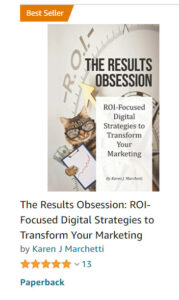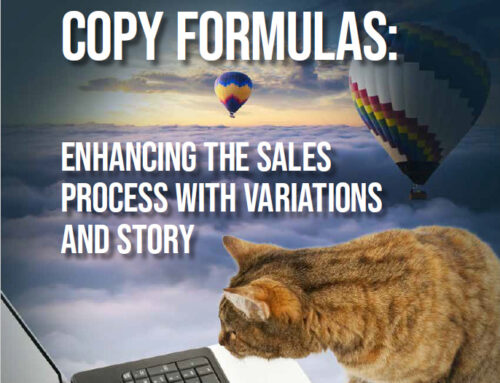On the eleventh day of digital marketing planning, your boss will ask of you:
“ELEVEN Copywriting Review Points . . .
TEN Content Marketing Questions . . . NINE Lead Generation Strategies . . . EIGHT Google Ads PPC Success Secrets . . . SEVEN Email Guidelines . . . SIX Website Improvements . . . FIVE Lead Capture Strategies . . . FOUR SEO Factors . . . THREE Design Directives . . . TWO Website Questions . . . and ONE Measurable Marketing Plan . . .”
Not sure how to evaluate the copy on your website? (Don’t assume it’s fine, when hidden problems could be lurking . . .)
Whether you’re writing copy, or just reviewing and editing copy, you should know how to recognize good copy (as well as copy that’s begging for some help).
Look at your copy from these 11 review points to discover missed opportunities to improve results:
1. Does it answer the question, “Why should I buy from you?”
If I spent 5 minutes on your website, could I tell why I should buy from you over the competition? (no matter on which page I might start?)
Most websites spend a lot of time talking about benefits that many other competitive products or companies also offer.
What makes your offering unique? What is your unique combination of benefits? Spell it out. Make it prominent. Don’t make your audience hunt for it — because they won’t.
If you can’t immediately answer the question, “why should I buy from you?”, how do you expect prospects to figure it out?
2. Have you built SPECIFICS into your headlines and subheads?
Specifics are what SELL. Specifics are what make your offering memorable. Specifics can provide the PROOF of your claims and add credibility. And Specifics also tend to answer objections.
Use Specific numbers whenever possible. Don’t say, “you’ll save thousands” if you can say, ”Our average customer saved $12,373 last year.” More memorable. More believable. And numbers in copy catch the eye and stand out.
3. Do you have “so what?” headlines?
Read the main headline on each of your web pages. If you can say, “so what?” after reading it, it’s not a good headline.
A headline needs to draw the reader in. Tell me WHY I should read the copy, tell me the key benefits I’ll learn about.
Banish general headlines like “Solutions” or “Products.”
Headlines aren’t just page “headings.” They should be benefit-laden directives designed to pull the reader into the copy.
Which page headline is more appealing?
Courses Or All the Required Hours to Renew Your License Tomorrow
How compelling are each of your page headlines?
4. Is your copy scannable?
Visitors view web pages in exactly the same manner that direct mail, magazine ads, and newspaper ads are reviewed. People SCAN, rather than read line-by-line, word-for-word.
If I scan just your headline and subheads, will I learn all the critical points you want me to learn? If I just scan, will I see key benefits that make me want to read the copy?
5. Is that the way you’d say it face-to-face?
Read your copy out loud. If that’s not exactly the way you’d say it face-to-face, revise it. Copy that’s conversational looks friendlier and is easier to read — so visitors will tend to read more and comprehend what they’ve read.
Conversational copy tends to use shorter sentences. Banish long sentences from your marketing efforts. (Some websites have sentences so long, they take up an entire paragraph of 4 or 5 lines. No one wants to read that!) Break things up with em dashes — or ellipses . . . or create separate sentences.
Conversational copy can have sentences start with “and” or “but” or “because.” These “connector” words make the copy seem smooth and effortless, rather than stiff and too “corporate”.
6. Are you talking to the visitor?
“Since 1987, we’ve been . . . we offer different models . . . our products can . . .”
This kind of “we”-focused copy is known as “wee-wee-ing” all over yourself. Not a pretty picture.
Turn your copy around to talk directly to your audience, * ̶ either by addressing the reader as “You” or leading with a verb (where the “you” is implied):
You’ll boost your response OR Boost your response
“You’ll work with a partner with 24 years experience . . . choose from 7 different models . . . your internal workflow will . . . ”
7. Are you incorporating emotion into your copy?
Anger, fear, flattery, greed, guilt, salvation, exclusivity (and in some cases, patriotism)
These 8 emotions have been found to be the key drivers of response.
Build one into your headline and lead paragraph to create a stronger, more emotional appeal that’s more likely to address your target audience’s pain.
8. Are you using strong action verbs?
Verbs are the action words that bring your copy to life. Inject strong action verbs into your writing, so every verb paints as specific a picture as possible (like the word “inject” in this sentence).
A copywriter could “write” your copy — or I could “craft” your copy. One is ordinary, but the other implies a special skill and a better outcome.
9. Are you leading with power words and phrases?
Because people scan, the first word or phrase in every headline and paragraph on a web page has a huge impact on response.
As you’re reviewing your headlines and body copy, look for powerful “lead” words/phrases that will interest your reader immediately.
Try to avoid useless and general introductory clauses like “As you may know” and similar empty phrases.
10. Is your copy “lean”?
Edit, edit, edit — be sure EVERY word needs to be there.
Don’t make your audience wade through copy that’s too general, too full of fluff, or that says the same thing that every competitor is saying.
11. Are you incorporating keywords to improve SEO
EVERY copywriter should understand at least the basics of Search Engine Optimization.
The copywriter should ALWAYS be the last one to touch your copy before it’s published on your website. So, work with your SEO consultant, to ensure you incorporate the appropriate keywords into headlines, subheads, anchor text for text links, image file names, and body copy.
You’ve worked hard to polish your copy. Be sure you’re the only one making final changes to it.
Did you miss: TEN Content Marketing Questions . . .
NINE Lead Generation Strategies . . .
EIGHT Google Ads PPC Secrets , , ,
SEVEN Truths of Email Marketing . . . SIX Website Improvements . . .
FIVE Lead Capture Strategies . . .
FOUR SEO Factors THREE Design Directives TWO Website Questions and ONE Measurable Marketing Plan
Need more detail on the planning points above? Our new BEST-SELLING book, “The Results Obsession: ROI-Focused Digital Strategies to Transform Your Marketing” is now available on Amazon!

Learn more about The Results Obsession and see the Table of Contents
The book includes chapters on Content Strategy, Characteristics of Great Copy, Website Copy, Email Copy, and more.






Leave A Comment